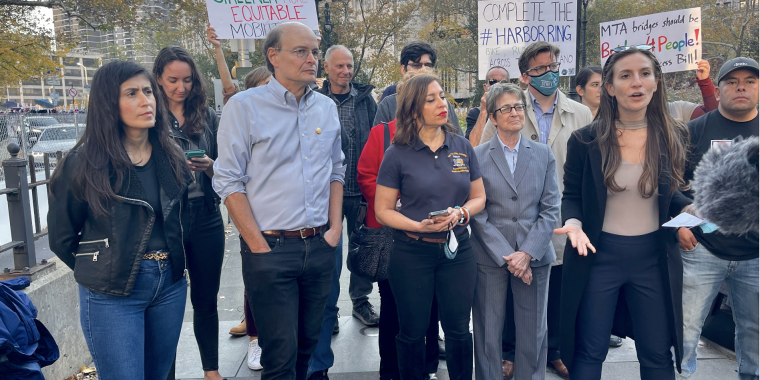
SENATOR BIAGGI AND ASSEMBLYMEMBER GONZÁLEZ-ROJAS JOIN ADVOCATES AND CYCLISTS TO CALL FOR GOVERNOR HOCHUL TO SIGN MTA BIKE ACCESS LEGISLATION INTO LAW
November 22, 2021

ALBANY, NY – State Senator Alessandra Biaggi and Assembly Member Jessica González-Rojas introduced bill S4943 (Assembly number forthcoming) to establish an advisory committee tasked with creating a strategic plan, in consultation with the MTA, to promote cycling and pedestrian access on MTA bridges and stations. Additionally, the legislation requires the MTA to consider and prioritize bicycle and pedestrian access when planning capital projects.
“Despite the rapid growth of bicycling in New York City over the last decade, the MTA has done little to improve bicycle access at its stations and prohibits cycling on its bridges altogether. As more New Yorkers have turned to cycling and outdoor spaces throughout the pandemic, we must continue to make our communities welcoming to cyclists and pedestrians and encourage residents to use clean forms of transportation. I'm proud to work in partnership with Assembly Member González-Rojas, Bike New York and StreetsPAC to develop this legislation to transform the MTA’s approach to bicycle and pedestrian access,” said New York State Senator Alessandra Biaggi.
“The benefits of cycling cannot be overstated. During this pandemic, New Yorkers have been able to exercise, sustain their mental health, and engage in a more environmentally sustainable form of transportation and it is our job to ensure we can increase their ability to do so. This legislation will create a mechanism by which we can ensure to improve the access to New Yorkers who want to cycle on MTA bridges by bringing stakeholders to the table. I’m excited to work with Senator Biaggi, Streets PAC, Bike New York, and all the advocates to get this passed and to support our cyclists in New York,” said Assembly Member Jessica González-Rojas.
"This legislation is critical for sustainable and equitable transportation in New York. Bicycling has been the fastest growing form of transportation in the city for years, and we saw bike use expand massively during 2020. But the MTA has ignored bike access on its bridges and the potential for bike-transit trips for decades. While the City of New York, the NY State Dept of Transportation, the Port Authority and Thruway Authority have made major strides to expand cycling and walking on the bridges that they manage, it seems it will take a law to bring the MTA to this particular table,” said Jon Orcutt, Advocacy Director for Bike New York.
“If we’re going to make it easier to get around the city by bicycle – which most everyone seems to agree is a good idea – making MTA bridges fully accessible by bike will be a necessity. And the same kind of need exists for vastly increasing bike parking around transit stations. This legislation will help tremendously on both counts, and we’re grateful to Senator Biaggi and Assembly Member González-Rojas for leading the effort,” said Eric McClure, StreetsPAC Executive Director.
“At a time when the City of New York is creating safe passage for bicyclists on city-operate bridges, the MTA refuses to open access for cyclists and pedestrians on the Verrazzano Bridge and other state-operated bridges. At a time when the City of New York is adding 10,000 new bike racks over the next two years, not a single MTA asset has installed secure bike parking for commuters during the ongoing bike boom. We’ve recently detailed the severe lack of bike parking in New York City and it’s time that the MTA catch up and utilize its significant footprint to better serve New Yorkers who want to park their bike at the train or want to bike across a bridge,” said Danny Harris, Executive Director at Transportation Alternatives.
“This legislation is an important step towards expanding cleaner and healthier transportation options in New York. Building a more robust bike network, as outlined in Regional Plan Association’s Five Borough Bikeway, will require better cycling access on MTA crossings and more bike parking at stations. We look forward to working with elected leaders and the MTA to advance this proposal,” said Kate Slevin, Senior Vice President of State Programs and Advocacy at Regional Plan Association.
"The MTA's rail and bridge infrastructure connects many New Yorkers to business centers, neighborhoods, and open spaces, but is currently leaving significant numbers of residents and visitors behind. The Verrazzano, Marine Parkway, Cross-Bay, Triboro, Whitestone, and Henry Hudson Bridges all have the untapped potential to be interboro greenway connectors. As our city looks forward to a better future and a sustainable recovery from COVID-19, it's time to make those connections truly inter-modal, and provide full bike and pedestrian access for essential, discretionary, and recreational trips," said Terri Carta, Executive Director of the Brooklyn Waterfront Greenway Initiative.
"Across the region, bridges are critical links in the bike transportation network, and almost every agency is recognizing this by expanding access. Yet the MTA, which operates key bridges that connect the outer boroughs with each other, has obstructed access for its entire existence. For Brooklynites looking to bike over the Verrazzano to Staten Island or the Marine Parkway Bridge to the Rockaways, MTA leadership has been more than indifferent — they've been aggressively hostile, using arbitrary and false safety claims to obscure their own failures and last-place status. This bill will be an important first step in catching the MTA up with its peers, and ending the leadership's pointless obstruction," said Brian Hedden, Bike South Brooklyn Co-Founder.
"The MTA's track record of neglecting walking and biking access to and through its facilities has left too many New Yorkers stranded for too long. Many transit hubs are difficult to access safely by foot or bike and nearly all lack secure bike parking facilities. MTA bridges range from substandard to hazardous to outright inaccessible. These barriers are unacceptable in a city striving to recover from the COVID pandemic, address systemic injustices, reduce traffic violence, and tackle climate change. This legislation will compel the MTA to bring its facilities and operations up to par to meet the needs of New Yorkers,” said Laura Shepard, Bike Network Organizer at Open Plans.
In contrast to every other transportation agency in New York City, the MTA does not allow bicycle access on its bridges, and has put little effort into improving bicycle access at bridges and stations.
This bill would create a standing advisory committee made up of 13 members appointed by the Governor and legislative leaders tasked with creating a strategic advisory plan for bicycle and pedestrian access in consultation with the MTA. The committee will also be tasked with reviewing existing capital projects to determine the impact of those projects on bicycle and pedestrian access and shall recommend any necessary modifications to promote access. Additionally, the MTA will be required as part of all future capital planning to consider bicycle and pedestrian access, in consultation with the standing advisory committee.
###
Share this Article or Press Release
Newsroom
Go to NewsroomSenator Biaggi Issues Statement Regarding NYT Investigation into Yeshivas
September 14, 2022
Senator Biaggi 2022 Woman of Distinction
August 26, 2022
